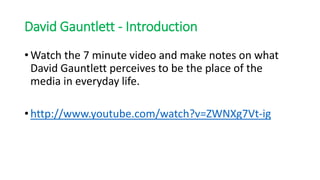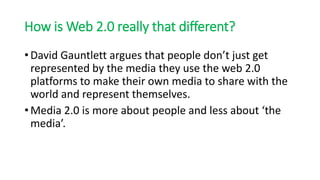Lesson 2 David Gauntlett
- 1. David GauntlettMedia in the Online Age
- 2. Web 1.0 vs Web 2.0 • Web 1.0 – No interaction. Information is provided for the user. • Web 2.0 – More collaborative, participatory and creative. Upload, share, download and create. • https://www.youtube.com/watch?v=wj3Maccx81s
- 3. Web 2.0 • “The phrase 'Web 2.0' was coined by Tim O'Reilly. 'Web 2.0' is, as mentioned above, not a replacement for the Web that we know and love, but rather a way of using existing systems in a 'new' way: to bring people together creatively. • The spirit of 'Web 2.0' is that individuals should open themselves to collaborative projects instead of seeking to make and protect their 'own' material. The 'ultimate' example at the moment is perhaps Wikipedia, the massive online encyclopedia created collectively by its millions of visitors. (Other examples include craigslist, del.icio.us, and Flickr).” (David Gauntlett) • Further Reading: http://www.theory.org.uk/mediastudies2.htm
- 4. David Gauntlett - Introduction • Watch the 7 minute video and make notes on what David Gauntlett perceives to be the place of the media in everyday life. • http://www.youtube.com/watch?v=ZWNXg7Vt-ig
- 5. What is Web 2.0? • User-generated material via software and hosted sites – YouTube, MySpace, Facebook – which have been labelled ‘Web 2.0’. • A way of using existing systems in a 'new' way: to bring people together creatively. • The 'ultimate' example at the moment is perhaps Wikipedia, the massive online encyclopaedia created collectively by its millions of visitors. • http://www.youtube.com/watch?v=nF4OBfVQmCI&feature=channel_ page
- 6. How is Web 2.0 really that different? • David Gauntlett argues that people don’t just get represented by the media they use the web 2.0 platforms to make their own media to share with the world and represent themselves. • Media 2.0 is more about people and less about ‘the media’.
- 7. Web 2.0 • More about people less about the media How the internet can transform a person’s life as their video goes viral. • http://www.youtube.com/watch?v=UCOC1YwNwZw • http://www.youtube.com/watch?v=5y3B6jipB90
- 8. Task • What examples can you find that support David Gauntlett’s theory? • Think about examples of creativity and people attempting to change culture (YouTube?) • Participatory culture – Wikipedia? Comments on YouTube? • What about people using the platforms of web 2.0 to represent/expose themselves – Vlogging (video blogs)? • Be prepared to feed your ideas to the rest of the group.
- 9. What do you think? • Charles Leadbeater opens up the debate suggesting how user generated material can be beneficial and also detrimental. • http://www.youtube.com/watch?v=qiP79vYsfbo • Develop a visual representation using examples to both support and challenge his response to the impact of web 2.0? (Gauntlett vs Leadbeater)








